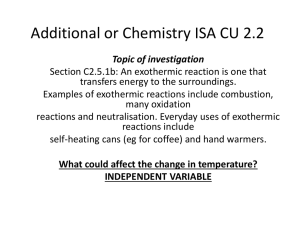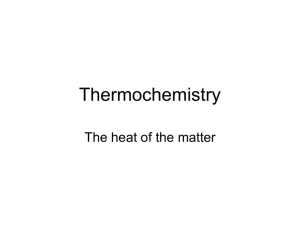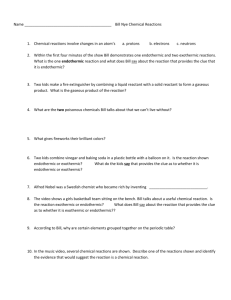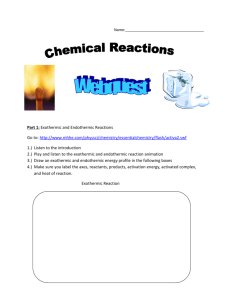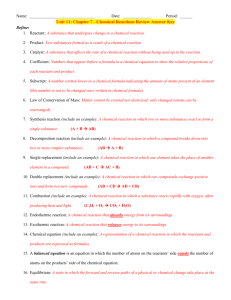Station 1
advertisement
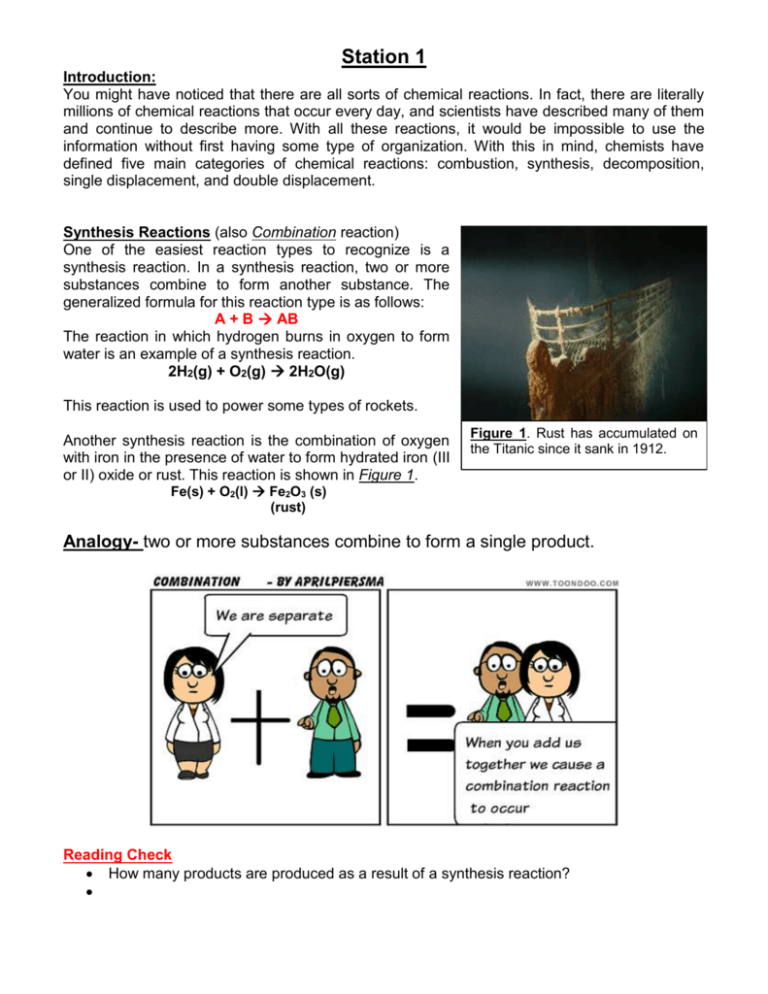
Station 1 Introduction: You might have noticed that there are all sorts of chemical reactions. In fact, there are literally millions of chemical reactions that occur every day, and scientists have described many of them and continue to describe more. With all these reactions, it would be impossible to use the information without first having some type of organization. With this in mind, chemists have defined five main categories of chemical reactions: combustion, synthesis, decomposition, single displacement, and double displacement. Synthesis Reactions (also Combination reaction) One of the easiest reaction types to recognize is a synthesis reaction. In a synthesis reaction, two or more substances combine to form another substance. The generalized formula for this reaction type is as follows: A + B AB The reaction in which hydrogen burns in oxygen to form water is an example of a synthesis reaction. 2H2(g) + O2(g) 2H2O(g) This reaction is used to power some types of rockets. Another synthesis reaction is the combination of oxygen with iron in the presence of water to form hydrated iron (III or II) oxide or rust. This reaction is shown in Figure 1. Figure 1. Rust has accumulated on the Titanic since it sank in 1912. Fe(s) + O2(l) Fe2O3 (s) (rust) Analogy- two or more substances combine to form a single product. Reading Check How many products are produced as a result of a synthesis reaction? Station 2 Decomposition Reactions A decomposition reaction is just the reverse of a synthesis. Instead of two substances coming together to form a third, a decomposition reaction occurs when one substance breaks down, or decomposes, into two or more substances. The general formula for this type of reaction can be expressed as follows: AB A + B Most decomposition reactions require the use of heat, light, or electricity. An electric current passed through water produces hydrogen and oxygen as shown in Figure 2. elec. 2H2O(l) 2H2(g) + O2(g) Figure 2. Water decomposes into hydrogen and oxygen when an electric current is passed through it. A small amount of sulfuric acid is added to increase conductivity. Notice the proportions of the gases collected. Describe how this is related to the coefficients of the products in the equation. Station 3 Combustion Reactions If you have ever observed something burning, you have observed a combustion reaction. Lavoisier was one of the first scientists to accurately describe combustion. He deduced that the process of burning (combustion) involves the combination of a substance with oxygen. A combustion reaction occurs when a substance reacts with oxygen to produce energy in the form of heat and light. Combustion reactions also produce one or more products that contain the elements in the reactants. For example, the reaction between carbon and oxygen produces carbon dioxide. Many combustion reactions also will fit into other categories of reactions. For example, the reaction between carbon and oxygen also is a synthesis reaction. Balance the following combustion equations: 1. Burning of coal: __C + ___O2 ___ CO2 2. Burning of the rocket fuel (liquid H2): ___H2 + ___O2 ____H2O 3. Burning of acetylene used in welding torches: ___C2H2 + ____O2 ____CO2 + _____H2O Reading Check What substance must be present for a combustion reaction to occur? What products are produced every time as a result of a combustion reaction? Are the heat and light energy released or absorbed during combustion? Station 4 Single Displacement When one element replaces another element in a compound, it is called a single-displacement reaction. Single-displacement reactions are described by the general equation A + BC AC + B Here you can see that atom A displaces atom B to produce a new molecule AC. A single displacement reaction is illustrated in Figure 3, where a copper wire is put into a solution of silver nitrate. Because cop- per is a more active metal than silver, it replaces the silver, forming a blue copper (II) nitrate solution. The silver, which is not soluble, forms on the wire. Cu(s) + 2AgNO3(aq) Cu(NO3)2 (aq) + 2Ag(s) Figure 3. Copper in a wire replaces silver in silver nitrate, forming a bluetinted solution of copper (II) nitrate. The Activity Series Sometimes single-displacement reactions can cause problems. For example, if iron-containing vegetables such as spinach are cooked in aluminum pans, aluminum can displace iron from the vegetable. This causes a black deposit of iron to form on the sides of the pan. For this reason, it is better to use stainless steel or enamel cookware when cooking spinach. We can predict which metal will replace another using the diagram shown in Figure 4, which lists metals according to how reactive they are. A metal can replace any metal below it on the list but not above it. Notice that copper, silver, and gold are the least active metals on the list. That is why these elements often occur as deposits of the relatively pure element. For example, gold is sometimes found as veins in quartz rock. Copper is found in pure lumps known as native copper. Other metals can occur as compounds. Reading Check Describe a single-displacement reaction Will magnesium replace aluminum in the single-replacement reaction? Figure 4. This figure shows the activity series of metals. A metal will replace any other metal that is less active. Which metal is more reactive, potassium or calcium? Station 5 Double Displacement In a double-displacement reaction, the positive ion of one compound replaces the positive ion of the other to form two new compounds. A double-displacement reaction takes place if a precipitate, water, or a gas forms when two ionic compounds in solution are combined. A precipitate is an insoluble compound that comes out of solution during this type of reaction. The generalized formula for this type of reaction is as follows: AB + CD AD + CB The reaction of barium nitrate with potassium sulfate is an example of this type of reaction. A precipitate—barium sulfate forms, as shown in Figure 5. The chemical equation is as follows: Ba(NO3)2(aq) + K2SO4(aq) BaSO4(s) + 2KNO3(aq) Reading Check Figure 5. Solid barium sulfate settles to the bottom of a test tube containing potassium nitrate. What type of reaction produces a precipitate? Observe: Has a chemical change occurred in the photo? How can you tell? These are a few examples of chemical reactions classified into types. Many more reactions of each type occur around you. Station 6 Acid-Base Reactions (Neutralization reactions) When magnesium and hydrochloric acid react, the resulting solution has properties characteristic of neither an acid nor a base. This type of reaction is called a neutralization reaction. A neutralization reaction is a reaction in which an acid and a base react in aqueous solution to produce a salt and water. A salt is an ionic compound made up of a cation from a base and an anion from an acid. Neutralization is a double-replacement reaction. In the reaction between magnesium hydroxide and hydrochloric acid, magnesium replaces hydrogen in HCl and hydrogen replaces magnesium in Mg(OH)2. The reaction may be described by this balanced formula equation. Mg(OH)2(aq) + 2HCl(aq) MgCl2(aq) + 2H2O(l) base + acid salt + water 2+ Note that the cation from the base (Mg ) is combined with the anion from the acid (Cl-) in the salt MgCl2. Station 7 Oxidation-Reduction Reactions One characteristic that is common to many chemical reactions is the tendency of the substances to lose or gain electrons. Chemists use the term oxidation to describe the loss of electrons and the term reduction to describe the gain of electrons. Chemical reactions involving electron transfer of this sort often involve oxygen, which is very reactive, pulling electrons from metallic elements. Corrosion of metal is a visible result, as shown in Figure 15. The cause and effect of oxidation and reduction can be taken one step further by describing the substances after the electron transfer. The substance that gains an electron or electrons obviously becomes more negative, so we say it is reduced. On the other hand, the substance that loses an electron or electrons then becomes more positive, and we say it is oxidized. The electrons that were pulled from one atom were gained by another atom in a chemical reaction called reduction. Reduction is the partner to oxidation; the two always work as a pair, which is commonly referred to as redox. Figure 15 One of the results of all of these electrons moving from one place to another might show up on the metal body of a tanker. Self Check 1. Classify each of the following reactions a. CaO(s) + H2O Ca(OH)2(aq) b. Fe(s) + CuSO4(aq) FeSO4(aq) + Cu(s) c. NH4NO3(s) N2O(g) + 2H2O(g) 2. Describe what happens in a combustion reaction. 3. Explain the differences between synthesis and decomposition reactions. 4. Determine, using the Activity Series chart, if zinc will displace gold in a chemical reaction and explain why or why not. 5. Think Critically In the reaction 2Na + Cl2 2NaCl, which atom is reduced and which atom is oxidized? Applying Math 1. Use proportions The following chemical equation is balance, but the coefficients used are larger than necessary. Rewrite this balanced equation using the smallest coefficients. 9Fe(s) + 12H2O(g) 3Fe3O4(s) + 12H2(g) 2. Use coefficients Sulfur trioxide, SO3, a pollutant released by coal-burning plants, can react with water in the atmosphere to produce sulfuric acid, H2SO4. Write a balanced equation for this reaction. Chemical Reactions and Energy Often a crowd gathers to watch a building being demolished using dynamite. In a few breathtaking seconds, tremendous structures of steel and cement that took a year or more to build are reduced to rubble and a large cloud of dust. A dynamite explosion, as shown in Figure 16, is an example of a rapid chemical reaction. All chemical reactions release or absorb energy. This energy can take many forms, such as heat, light, sound, or electricity. The heat produced by a wood fire and the light emitted by a glow stick are two examples of reactions that release energy. Conservation of Energy in Chemical Reactions According to the law of conservation of energy, energy cannot be created or destroyed, but can only change form. In com- pounds, chemical potential energy is stored in chemical bonds between atoms. In some chemical reactions, chemical potential energy is changed to other forms of energy, such as heat or light, and is released. In other chemical reactions, forms of energy such as heat or light are converted to chemical potential energy and stored in bonds that form, and energy is absorbed. In all chemical reactions, energy is never created or destroyed, but only changes form. All reactions follow the laws of conservation of mass and energy. When the atoms in a reaction “rearrange” in going from reactants to products, they break existing chemical bonds and form new ones Breaking a chemical bond requires energy. When energy is absorbed in a chemical reaction, this is where it goes. By the same token, the formation of a chemical bond releases energy. In an exothermic reaction, this is where the released energy comes from. It shouldn’t be surprising that breaking a bond, of any kind, requires an input of energy. Imagine the bond between two strong magnets, for example: you have to work pretty hard to get them apart. What is less obvious is that forming a bond releases energy. Think of the magnets again. If they are close enough to attract each other, they will pull your hands together as they bond – doing work (another form of energy) on you in the process. Heat Absorption When the energy needed is in the form of heat, the reaction is called an endothermic reaction. The term endothermic is not just related to chemical reactions. It also can describe physical changes. The process of dissolving a salt in water is a physical change. If you ever had to soak a swollen ankle in an Epsom salt solution, you probably noticed that when you mixed the Epsom salt in water, the solution became cold. The dissolving of Epsom salt absorbs heat. Thus, it is a physical change that is endothermic. Some reactions are so endothermic that they can cause water to freeze. One such endothermic reaction is that of barium hydroxide (Ba(OH)2) and ammonium chloride (NH4Cl) in water, shown in Figure 17. Figure 17 As an endothermic reaction happens, such as the reaction of barium hydroxide and ammonium chloride, energy from the surrounding environment is absorbed, causing a cooling effect. Here, the reaction absorbs so much heat that a drop of water freezes and the beaker holding the reaction sticks to the wood. Heat Release You have seen many reactions that release energy. Chemical reactions that release energy are called exergonic (ek sur GAH nihk) reactions. In these reactions, less energy is required to break the original bonds than is released when new bonds are formed. As a result, some form of energy, such as light or heat, is given off by the reaction. The familiar glow from the reaction inside a glow stick, shown in Figure 19, is an example of an exergonic reaction, which produces visible light. In other reactions, however, energy is released as heat. This is the case with some heat packs that are used to treat muscle aches and other medical conditions. Another release of energy is used to power rockets, as shown in Figure 20. Exothermic Reactions When the energy given off in a reaction is primarily in the form of heat, the reaction is called an The burning of wood and the explosion of dynamite are exothermic reactions. Iron rusting is also exothermic, but, under typical conditions, the reaction proceeds so slowly that it’s difficult to detect any temperature change. Why is a log fire considered to be an exothermic reaction? Exothermic reactions provide most of the power used in homes and industries. Fossil fuels that contain carbon, such as coal, petroleum, and natural gas, combine with oxygen to yield carbon dioxide gas and energy. Unfortunately impurities in these fuels, such as sulfur, burn as well, producing pollutants such as sulfur dioxide. Sulfur dioxide combines with water in the atmosphere, producing acid rain. Exothermic reactions transfer energy to the surroundings. Endothermic reactions take in energy from the surroundings. Reversible reactions are where the products can react to remake the original reactants. If the forward reaction is exothermic, the reverse reaction is endothermic. Exothermic reactions When a chemical reaction occurs, energy is transferred to or from the surroundings - and there is often a temperature change. Exothermic reactions transfer energy to the surroundings. The energy is usually transferred as heat energy, causing the reaction mixture and its surroundings to become hotter. The temperature increase can be detected using a thermometer. Some examples of exothermic reactions are: Combustion (burning) Many oxidation reactions, for example rusting Neutralisation reactions between acids and alkalis When a flame burns it transfers heat to its surroundings. Exothermic reactions can be used for everyday purposes. For example, hand warmers and self-heating cans for drinks (such as coffee) use exothermic reactions. Endothermic reactions These are reactions that take in energy from the surroundings. The energy is usually transferred as heat energy, causing the reaction mixture and its surroundings to get colder. The temperature decrease can also be detected using a thermometer. Some examples of endothermic reactions are: Electrolysis The reaction between ethanoic acid and sodium carbonate The thermal decomposition of calcium carbonate in a blast furnace Endothermic reactions can be used for everyday purposes. For example, certain sports injury cold packs use endothermic reactions. The animation shows an exothermic reaction between sodium hydroxide and hydrochloric acid, and an endothermic reaction between sodium carbonate and ethanoic acid. http://www.bbc.co.uk/schools/gcsebitesize/science/add_aqa/exothermic/exothermic_endothermi crev2.shtml

